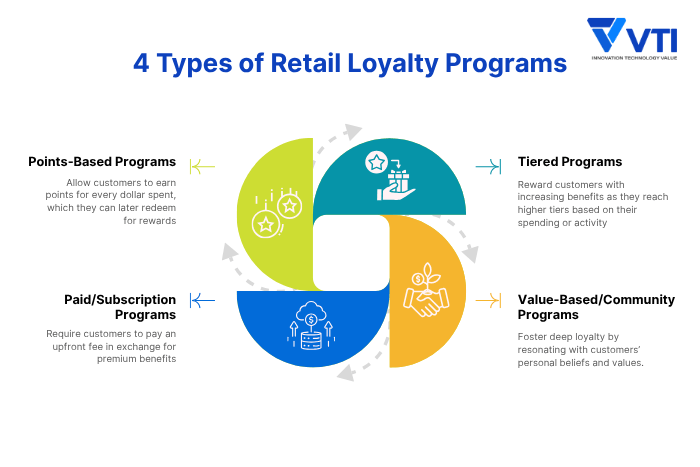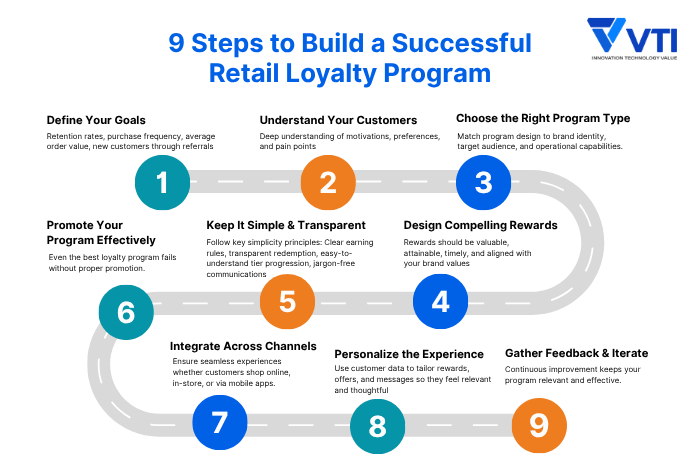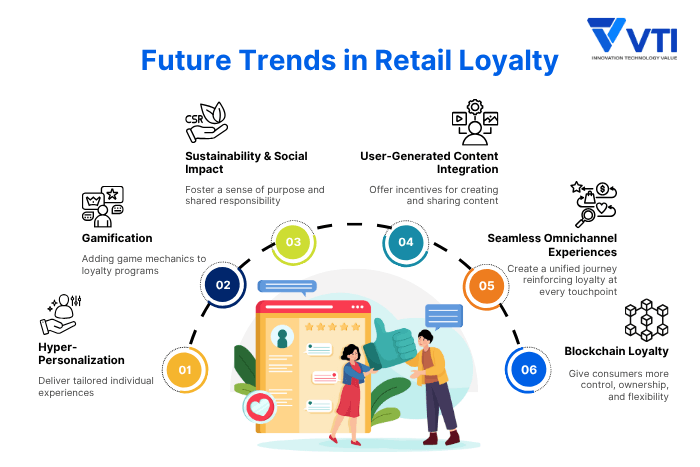Numbers can tell a compelling story. Acquiring a new customer costs 5 to 7 times more than retaining an existing one, making retail loyalty a far more cost-effective and profitable strategy. Moreover, loyal customers spend on average 67% more than new customers, emphasizing the financial impact of fostering long-term relationships over short-term sales.
Customer retention doesn’t just drive immediate revenue; it builds a foundation for sustainable growth. Think of loyal customers as your business’s best friends—they advocate for you, stick around during tough times, and help you grow through word-of-mouth recommendations.
This guide explores the meaning of retail loyalty, its business importance, various types of loyalty programs, practical steps to build your program, and how to measure success and leverage future trends to stay competitive. Follow VTI to learn more about retail loyalty (best platforms, apps, cost of implementing…) on the upcoming blogs.
What is Retail Loyalty?
Definition: More Than Just Repeat Purchases
When most people think of retail loyalty, they imagine customers who buy again and again. While this is a goal for all customer loyalty programs in retail, true retail loyalty goes much deeper than repeated purchases.
Real retail loyalty is about consistent emotional engagement cultivated through trust and alignment with brand values. It’s what makes customers choose your brand over competitors, even when alternatives are readily available and sometimes cheaper.
Think about your own shopping habits. Why do you choose iPhone over Android, or Starbucks over the local coffee shop? It’s rarely just about the product – it’s about how the brand makes you feel and what it represents to you.
Key Components of Loyalty
Repeat Purchases Loyal customers return without needing constant promotions or discounts. They’ve developed a habit and preference for your brand. It’s like having a regular dinner spot – you go there because you know what to expect and you like it.
Brand Preference Even with competitors present, loyal customers actively choose your brand. They might walk past three other coffee shops to get to their favorite one. This preference creates a competitive advantage that’s hard to replicate.
Advocacy Here’s where loyalty gets really powerful. Loyal customers become your unpaid marketing team. They write positive reviews, refer friends, and share their experiences on social media.
Resistance to Competitors Loyalty creates what psychologists call “switching costs.” Even if a competitor offers a better deal, loyal customers feel a psychological cost in switching. They’d rather stick with what they know and trust.
Why is Retail Loyalty Crucial for Your Business?

Increased Customer Lifetime Value (CLTV)
Let’s talk numbers. According to Bain & Company, increasing customer retention rates by just 5% can increase profits by 25% to 95%. A loyal customer doesn’t just buy once – they buy repeatedly, and they tend to spend more over time.
If a retail loyalty program treats all customers the same – without considering their growth potential – it risks missing out on high-value opportunities and could ultimately face significant losses. Meanwhile, predictive analytics and personalized engagement that recognizes and nurtures customer journey stages helps retailers plan better, invest smarter, and grow more confidently.
>> Read more: Expand Customer Lifecycle With The Customer Loyalty Application – VTI
Reduced Marketing Costs
One-size-fits-all campaigns waste budget on broad acquisition while neglecting retention optimization. Marketers consistently report that retention-focused campaigns deliver better ROI than acquisition campaigns. According to HubSpot, retention-focused campaigns deliver up to 3x the ROI compared to acquisition efforts.
An effective retail loyalty program with AI-driven optimization can analyze customer behavior and automatically allocate budget toward high-value retention opportunities.
Brand Advocacy & Referrals
A study in the Journal of Marketing found that referred customers have a 16% higher lifetime value and are 18% more likely to stay loyal. It’s like loyalty breeds loyalty – your best customers help you find more best customers. Word-of-mouth referrals from loyal customers are marketing gold, yet traditional systems can’t identify which customers are most likely to refer or how to motivate them effectively.
Here’s what’s needed: a smarter retail loyalty system that includes social influence mapping and automated advocacy activation, using customer behavior patterns to pinpoint and engage potential brand advocates.
Valuable Data & Insights
According to McKinsey, companies that leverage customer behavior data outperform peers by 85% in sales growth and 25% in gross margin. Loyalty programs for retailers are data goldmines. Every interaction tells you something about your customers: what they buy, when they buy, how much they spend, and what motivates them.
This data enables precise segmentation. Instead of sending the same promotion to everyone, you can send targeted offers that actually resonate. Only real-time behavioral analytics with automated insight generation and action recommendations can help you do so.
Competitive Advantage
Strong loyalty, often nurtured through effective loyalty programs for retailers, creates what business strategists call a “moat” around your business. When customers are emotionally invested in your brand, competitors can’t simply steal them with lower prices or flashy marketing. This protection becomes especially valuable during economic downturns or increased competition. Loyal customers stick with brands they trust, even when times get tough.
Yet, traditional programs fail to create this “moat” that protects against competitive threats during market pressure. Retailers need a retail loyalty program that creates emotional brand investment beyond transactional benefits.
Improved Profitability
Retailers today face a trio of persistent challenges: rising customer acquisition costs, decreasing attention spans, and growing competition across both physical and digital shelves. Traditional retail loyalty efforts are no longer enough to sustain long-term growth or profitability.
That’s where smart loyalty programs come in. They not only retain existing customers but also drive repeat purchases, increase average order value, and lower marketing spend, adding up to one crucial outcome: stronger profit margins. In fact, many successful retailers report that loyalty program members generate 15–25% more revenue than non-members – while also costing less to acquire and retain.
Types of Retail Loyalty Programs
This section explores the most common types of retail store loyalty programs.

Points-Based Programs
Points-based loyalty programs allow customers to earn points for every dollar spent, which they can later redeem for rewards – a model that’s popular because it’s simple, instantly gratifying, and lets customers easily track their progress.
Brands like Starbucks Rewards, where purchases earn stars redeemable for free drinks and food, and Sephora’s Beauty Insider, which offers points in exchange for exclusive products and experiences, exemplify this approach.
However, if not carefully managed, these programs risk becoming commoditized, with customers participating only during promotions and weakening their emotional connection to the brand.
Tiered Programs
Tiered loyalty programs reward customers with increasing benefits as they reach higher tiers based on their spending or activity, leveraging the human drive for status and achievement to boost engagement and motivation.
For example, airline frequent flyer programs offer escalating perks across Silver, Gold, and Platinum tiers, while Nordstrom’s program grants higher-tier members early access to sales, exclusive events, and personalized styling services.
This model works best for businesses with a broad spectrum of customer value and the ability to deliver compelling, differentiated rewards at each tier.
Paid/Subscription Programs
Paid loyalty programs require customers to pay an upfront fee in exchange for premium benefits such as free shipping, exclusive access, or special pricing – offering businesses predictable revenue and fostering stronger customer commitment, as paying members are more inclined to stay engaged.
Amazon Prime set the standard with its combination of free shipping, streaming services, and exclusive deals, while Walmart+ mirrors this model to compete directly.
Although the initial cost can be a barrier to entry, it also ensures that those who join are highly motivated to extract value from their membership.
Value-Based/Community Programs
Value-based loyalty programs focus on shared ideals – such as sustainability, social causes, or lifestyle alignment – rather than transactional rewards, fostering deep loyalty by resonating with customers’ personal beliefs and values.
For instance, REI Co-op shares profits with its members while supporting outdoor conservation efforts, and Patagonia integrates environmental activism and sustainability into its loyalty initiatives.
Although these programs can be more difficult to measure in terms of direct ROI, they often cultivate the most powerful emotional connections and long-term brand affinity.
Hybrid Models
Hybrid loyalty programs blend multiple strategies – such as points systems, tiered rewards, value-driven initiatives, and community engagement – to deliver a more holistic and personalized loyalty experience.
A prime example is Nike Membership, which integrates points accumulation, tier-based perks, exclusive product access, and community features like running clubs and fitness apps.
These models are effective because they appeal to diverse customer motivations and offer multiple engagement channels, making it easier to build lasting, multifaceted relationships with a broad audience.
Features To Look For In A Retail Loyalty Solution
When choosing a loyalty program platform, think of it like selecting a business partner. The right solution will grow with you and make your life easier, while the wrong one will create headaches and limitations.
Technical Integration Capabilities
Ease of Integration: Your loyalty platform should play nicely with your existing systems – POS terminals, CRM databases, e-commerce platforms, and inventory management. The last thing you want is a loyalty program that requires customers to have separate accounts or creates data silos.
Omnichannel Support: Modern customers shop everywhere – online, in-store, on mobile apps. Your loyalty program should provide seamless experiences across all these channels. A customer should be able to earn points in-store and redeem them online without any friction.
Customization and Flexibility
Program Customization: Every business is different. Effective customer loyalty programs in retail are not one-size-fits-all. Look for solutions that let you tailor rewards, tier structures, and program rules to match your brand identity and customer needs.
Scalability: Choose a platform that can grow with your business. Whether you have 1,000 members or 100,000, the system should handle the load without performance issues.
Analytics and Insights
Data Analytics & Reporting: Robust reporting tools help you track key performance indicators, understand customer behavior, and measure program ROI. Look for real-time dashboards and customizable reports.
Personalization Capabilities: Advanced platforms use customer data to create personalized experiences – targeted offers, product recommendations, and customized communications based on purchase history and preferences.
Automation and Support
Automation Features: Automated reward delivery, birthday offers, and segmented email campaigns save time and ensure consistent customer experiences.
Customer Support: Reliable support from your platform provider is crucial. When technical issues arise, you need quick resolution to avoid disrupting customer experiences.
Security and Compliance
Data Security: Customer data protection is non-negotiable. Ensure your chosen platform meets industry security standards and compliance requirements, especially important for businesses operating across different countries in the Asia-Pacific region.
9 Steps to Build a Successful Retail Loyalty Program

Step 1: Define Clear Goals
Start by identifying exactly what you want your loyalty program to achieve. Goals could include increasing customer retention, boosting purchase frequency, raising average order value, or driving referrals. Make sure your goals are specific and measurable. Instead of vague targets like “increase loyalty,” aim for something like “grow repeat purchase rate from 30% to 45% within six months.”
Step 2: Understand Your Customers
The success of your program depends on how well it fits your customers’ needs. Use both data and direct feedback to understand what motivates them, what they value, and what keeps them coming back. This blend of quantitative and qualitative insights will help you create a program that resonates.
Step 3: Choose the Right Program Type
Select a loyalty model that fits your brand, business type, and customer behavior.
- Points-based programs work well for businesses with frequent, smaller purchases (e.g., coffee shops).
- Tiered programs suit high-value, less frequent purchases (e.g., furniture or luxury goods).
- Paid programs (like memberships) are great for subscription-based models.
- Cause-driven or community-based programs appeal to socially conscious customers.
Step 4: Design Meaningful Rewards
Your rewards should be valuable, desirable, and achievable. Mix monetary rewards (like discounts or free products) with emotional rewards (like exclusive access, early sales, or VIP experiences).
Include both short-term and long-term incentives – easy-to-earn rewards for quick engagement and aspirational ones to retain long-term customers. Surprise rewards are a bonus: they create delight and deepen loyalty.
Step 5: Keep It Simple and Transparent
Simplicity drives participation. If customers can’t understand how to earn or use rewards, they’ll give up. Use plain language, clear earning rules, and intuitive redemption processes. Make tier progression visible and easy to track.
Step 6: Promote Your Program Effectively
Even the best loyalty program needs strong promotion. Train your staff to confidently explain the benefits and enrollment process. Integrate promotion into all channels – email, social media, website, packaging, POS displays, and even receipts. Remind customers at key moments (like checkout) to join or use the program.
Step 7: Integrate Across Channels
Customers expect a seamless experience. Whether they shop online, in-store, or through an app, their loyalty rewards should follow them. This means syncing data and systems to ensure one customer profile, consistent points tracking, and smooth reward redemption across platforms.
Step 8: Personalize the Experience
Generic rewards don’t build real loyalty. Use customer data to tailor offers and communications. Segment by shopping behavior, preferences, and lifecycle stage. Offer personalized product suggestions, birthday gifts, or loyalty anniversaries to make customers feel recognized and valued.
Step 9: Gather Feedback and Continuously Improve
Launch with a basic version of your program and improve it over time. Monitor performance metrics (e.g., redemption rates, retention rates), collect customer feedback, and experiment with new features. Regularly review your program and adjust it based on what works – and what doesn’t. Staying agile keeps your program fresh and effective.
Measuring the Success of Your Retail Loyalty Program
Key Performance Indicators (KPIs)
Enrollment Rate What percentage of customers join your loyalty program? A low enrollment rate might indicate unclear value proposition or complicated signup process.
Redemption Rate Are customers actually using their rewards? High point accumulation with low redemption suggests rewards aren’t compelling or accessible enough.
Repeat Purchase Rate How often do loyalty members return compared to non-members? This is a direct measure of the program’s impact on customer behavior.
Customer Lifetime Value (CLTV) Compare the lifetime value of loyalty members versus non-members. The difference represents your program’s value creation.
Average Order Value (AOV) Do loyalty members spend more per transaction? Programs often drive increased basket sizes through targeted promotions and tier benefits.
Churn Rate How many customers stop engaging with your brand over time? Lower churn rates among loyalty members indicate program effectiveness.
Tools for Measurement
CRM Systems: Platforms like Salesforce or HubSpot help track customer interactions and calculate lifetime values.
Loyalty Management Platforms: Specialized customer loyalty program software and platforms like Smile.io, LoyaltyLion, or Yotpo provide built-in analytics focused on program performance.
Analytics Tools: Google Analytics, Adobe Analytics, or Klaviyo offer detailed insights into customer behavior and campaign performance.
Business Intelligence: Tools like Tableau or Power BI help visualize complex data and identify trends across your loyalty program metrics.
Future Trends in Retail Loyalty

Hyper-Personalization
Powered by artificial intelligence, Hyper-personalization allows brands to go beyond traditional segment-based marketing and instead deliver tailored experiences at the individual level.
This enables loyalty programs to offer dynamic pricing strategies that reflect each customer’s value and responsiveness, real-time product recommendations that update as customers browse online or in-store, and personalized rewards that are far more relevant and compelling than standard discounts.
Furthermore, predictive analytics allow brands to anticipate customer needs before they’re expressed, enabling a proactive approach that not only enhances satisfaction but also deepens brand loyalty.
Gamification
Adding game mechanics to loyalty programs makes them more engaging and fun. Customers today crave experiences that are not just transactional but also entertaining and rewarding in more meaningful ways.
By incorporating game-like elements such as achievement badges for completing specific actions (e.g., first-time purchases, product reviews, social media sharing), leaderboards showcasing top-performing customers or advocates, and tiered challenges or missions that guide behavior, brands can make loyalty programs feel more like a journey than a series of isolated rewards.
Progress visualization tools – such as progress bars or status dashboards – help motivate continued participation, while surprise rewards and digital “loot boxes” inject excitement and unpredictability, further driving engagement.
Sustainability & Social Impact
Consumers – especially younger demographics in regions like Asia-Pacific – are increasingly inclined to support brands that reflect their environmental and social values.
Forward-thinking loyalty programs are tapping into this shift by enabling customers to redeem points to fund carbon offset programs, rewarding sustainable behaviors like using reusable bags or choosing eco-friendly products, and offering transparency around how customer purchases and loyalty engagement support community or charitable initiatives.
By allowing members to contribute to causes they care about, loyalty programs foster a sense of purpose and shared responsibility between brand and consumer.
User-Generated Content Integration
The integration of user-generated content (UGC) into loyalty ecosystems is also gaining traction. Customers are no longer passive recipients of marketing – they’re active participants and brand storytellers.
Loyalty programs encourage this dynamic by offering incentives for creating and sharing content, such as awarding points for social media posts featuring branded products, offering exclusive rewards for in-depth product reviews, or showcasing member spotlights that recognize loyal users publicly.
Brands are also launching creative contests and challenges that invite customers to contribute photos or testimonials, which not only build a sense of community but also generate authentic marketing content.
Seamless Omnichannel Experiences
As digital touchpoints proliferate, the demand for seamless omnichannel loyalty programs becomes more urgent. Today’s consumers expect to engage with brands consistently, regardless of whether they’re shopping in a physical store, browsing a mobile app, chatting with a voice assistant, or scrolling through Instagram.
Loyalty programs are adapting by becoming increasingly channel-agnostic, integrating across all customer interaction points. This includes innovative features like voice commerce capabilities through platforms like Amazon Alexa and Google Assistant, augmented reality tools that enhance the in-store experience, social commerce links that reward purchases made directly through social media, and IoT-enabled devices that automate reordering and loyalty tracking. The goal is to create a frictionless, unified journey that reinforces loyalty at every touchpoint.
Web3/Blockchain Loyalty
The rise of Web3 and blockchain-based loyalty systems is beginning to redefine the very structure of rewards programs. Although still in the early stages of mainstream adoption, these technologies promise to give consumers more control, ownership, and flexibility in how they engage with loyalty ecosystems.
For instance, blockchain can enable NFT-based rewards that customers actually own and can trade or resell, while cryptocurrency-based loyalty systems allow for points that can be spent across multiple brands. Decentralized loyalty networks could eventually make loyalty currencies fully interoperable, offering unprecedented freedom and value to users.
Additionally, the use of blockchain for verification brings enhanced transparency and security, which can help increase trust – especially important as data privacy becomes a growing concern among consumers.
Conclusion: Cultivating Lasting Relationships
The retail landscape will continue evolving. New technologies will emerge, customer expectations will shift, and competitors will try to copy your strategies. But businesses that focus on genuine relationship building through thoughtful loyalty programs will always have a competitive advantage.
The question isn’t whether you need a loyalty program – it’s whether you’re ready to build meaningful relationships that last.
Ready to build a results-driven loyalty program tailored to your business needs? VTI’s comprehensive retail solutions and extensive experience with Japanese retailers in the Asia-Pacific region can help you create loyalty programs that drive real results. Contact us for a personalized consultation and let’s grow together.
![[FREE EBOOK] Strategic Vietnam IT Outsourcing: Optimizing Cost and Workforce Efficiency](https://vti.com.vn/wp-content/uploads/2023/08/cover-mockup_ebook-it-outsourcing-20230331111004-ynxdn-1.png)




